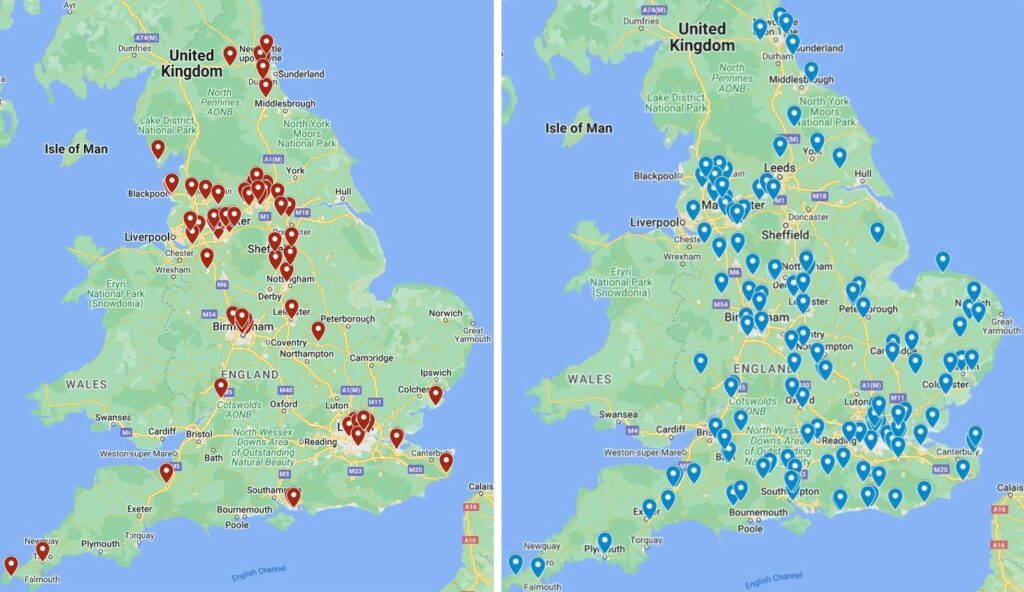
Nursery closure rates up fifty per cent on previous academic year
Nurseries in England continue to close at an alarming rate, with fifty per cent more closures in the academic year 2022-23, compared with the previous year, according to research by National Day Nurseries Association (NDNA).
The data looked at closures between September 2022 to the start of this academic year and found that 72 more nurseries closed compared with the same period the year before, an increase of 50%. This takes place as parents and providers are gearing up for the planned expansion of Government-funded childcare places from April 2024.
While closures affect all areas, analysis of the data continued to show that they are most likely to take place in the areas of greatest deprivation. In the last academic year alone 14.5% of nursery closures were in the 10% most deprived areas of England. This is on top of 12.7% in the 10% most deprived areas the previous year.

The red map shows nursery closures in the top three areas of deprivation in England and the blue map highlights the remaining seven areas.
The data also showed that closures were accelerating at a time when nurseries are usually at their busiest. Over one third (36%) of closures happened in the summer between April to August. This coincided with the cost increases which came into effect at the start of the financial year. While NDNA members reported 14% increases in their staffing costs alone, the Government funding rate only went up by an average of 3.4%.
Purnima Tanuku OBE, Chief Executive of NDNA said: “The alarming rate at which nurseries are continuing to close puts in doubt the Governments’ ability to deliver on their promise of more funded childcare from April 2024.
“Our research shows that the rate of closures has increased by 50% compared with the previous academic year and highlights the devasting impact that years of underfunding has had on the childcare sector. Providers are currently facing significant pressures on their finances and yet the Government’s funding simply does not cover their costs.
“What we are seeing is a reduction in the number of nurseries when you would expect to see more capacity being created for any expansion. This is because the Government is not taking full account of increased staffing costs, higher energy prices, food price hikes and a workforce crisis. As a result, parents may be struggling to find childcare places, with some facing the decision of whether to give up work or change careers for lack of affordable childcare.
“The fact that more closures happen in areas of deprivation continues to ring alarm bells. These are settings which have more Government funded places and are hit harder by underfunding. Research shows that these are the children who have most to gain from accessing high quality early education and care. We have to make sure this policy is not creating childcare deserts.
“The Government must take urgent action to support every childcare provider to be able to deliver sustainable childcare that is accessible and affordable for all if they are seriously committed to their promise of the expansion of funded childcare from April 2024.”
Many providers are still trying to find out what rate they will receive from their local authority following the announcement of an additional £204m that the Government announced to boost to funding rates. NDNA is aware that not all local authorities plan to pass 100% of the funding through to providers through their base hourly rates and some local authorities will not be able to pay providers the new increased rate until later this term. This is causing these nursery businesses major cash flow issues.
Nursery closures investigation:
- In the academic year 2022-23 (data checked up to 8 September 2023) we documented 216 nursery closures in England compared with 144 during 2021-22
- This is an increase of 50% across the academic year 2022-23
- Closures in the top three areas of deprivation are in the city hotspots of Newcastle, Leeds, Bradford, Manchester, Birmingham and London
- Nursery closures are wide-spread across the UK, impacting on all areas.
- The figures build on Ofsted data which revealed a net loss of 651 early years registered settings in the year March 2022 to March 2023
Case study – nursery owner, East Midlands – closed two of four nurseries
“I have had to close two nurseries as the costs became too much to bear. This has caused financial, health and mental health implications for myself. Covid increased costs with additional borrowing needed. This meant to recover we would need to increase our income to cover this increase in borrowing costs.
“Historically there has also been an underfunding. National Minimum Wage was introduced in April 1999. The top rate of NMW used to be £5.93 and increased to £10.42 in April 2023, during which time my funding rate for three and four-year-olds has increased by 5% overall, not each year.
“That is a 33.9% increase in staffing costs alone compared to a 5% increase in funding. This funding rate is also top-sliced by the local authorities at different rates across the country. We also had increases in inflation, meaning food and other costs have also increased. In addition, this year the business rates calculations have altered to increase costs further for many nurseries.
“Whilst demand is increasing, this is due to a decrease in provision, highlighted by Ofsted’s own figures. The government’s own reports have shown that nurseries are underfunded, but this has been ignored and now the increase in funded – not “free” – hours will exacerbate the issue for many nurseries.”
- England
Similar Articles
Huge Government boost will fund many more Maths Champions

Parent survey shows benefits and challenges of funded childcare policy


